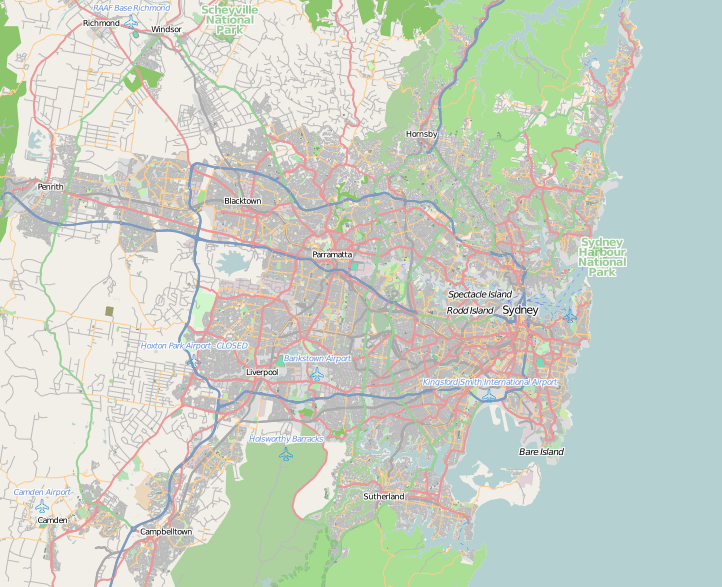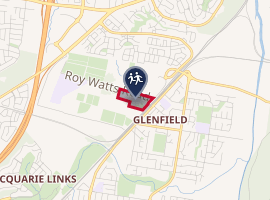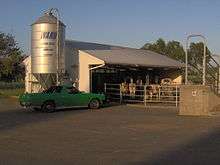Hurlstone Agricultural High School
Hurlstone Agricultural High School (HAHS, colloquially as Hurlstone Ag) is a government-funded co-educational academically selective and specialist secondary day and boarding school, located in Glenfield, a south-western suburb of Sydney, in the Macarthur region of New South Wales, Australia. HAHS is the oldest government boarding school in New South Wales.[1]
| Hurlstone Agricultural High School | |
|---|---|
 | |
| Location | |
 Hurlstone Agricultural High School Location in greater metropolitan Sydney | |
Australia | |
| Coordinates | 33°58′14″S 150°53′29″E |
| Information | |
| Type | Government-funded co-educational academically selective and specialist secondary day and boarding school |
| Motto | Latin: Pro Patria (For my country) |
| Established | 1 April 1907 |
| Founder | John Kinloch principal = |
| Educational authority | NSW Department of Education |
| Specialist | Agricultural school |
| Teaching staff | c. 50 |
| Years | 7-12 |
| Enrolment | c. 1,080 |
| Campus | Suburban |
| Campus size | 112 hectares (280 acres) |
| Colour(s) | Blue, red and gold |
| Website | www |

| |
Farrer Memorial Agricultural High School, Yanco Agricultural High School and Hurlstone Ag are the state's only public selective and agricultural schools that also include a co-educational boarding school. The 112-hectare (277-acre) Hurlstone Ag campus includes classroom blocks, an operational farm, sporting facilities and student accommodation.[2]
Hurlstone was named the Macarthur region's best academic school, ranking 11th in the NSW top 200 list for the 2012 academic year. The school had 148 distinguished achievers, 13 on the state's top achievers' list, eight on the all-rounders' list and three students who topped the state in a course. Students are required to sit the Selective High Schools Test in year 6 to be granted enrolment into the school. The allowance mark is usually between 200 and 205 in the Selective test (out of 300). Students can also gain entrance by sitting a similar exam in other grades.
History

Hurlstone was established as a boys-only school in 1907 in Hurlstone Park, approximately ten kilometres south west of Sydney, at the present site of Trinity Grammar School. The original owner of the land was a teacher, John Kinloch, one of the first graduates of the University of Sydney. He named the land 'Hurlstone Estate', after his mother's maiden name and set up his own school on it in 1878 which he called the Hurlstone School and College.[3]
In those days most students completed their schooling after primary school and students at 'Hurlstone Agricultural Continuation School' (as it was known at the time) studied there for only two years. In 1926 the school moved to its present site in Glenfield, approximately 42 km south-west of Sydney (between Liverpool and Campbelltown) and adjacent to Glenfield railway station. By then its student numbers had grown from 30 in 1907, to 148.[3] The school supported government policy to promote productivity in the agricultural sector through the training of boys in all aspects of agricultural sciences and farm management.
For a brief period in the early 1940s it was known as 'Macarthur Agricultural High School' in honour of wool-grower John Macarthur, but it soon reverted to its previous name.
Hurlstone was a boys' school until 1979, when the decision was made to become co-educational.[3]
Principals

The following individuals have served as principal of the Hurlstone Agricultural High School:
| Ordinal | Officeholder | Term start | Term end | Time in office | Notes |
|---|---|---|---|---|---|
| 1 | Frank McMullen | 1907 | 1916 | 8–9 years | |
| 2 | George Longmuir | 1917 | 1938 | 20–21 years | |
| 3 | Percival Hindmarsh | 1939 | 1945 | 5–6 years | |
| 4 | James McEwan King | 1946 | 1953 | 6–7 years | |
| 5 | Clarence G. James | 1954 | 1967 | 12–13 years | |
| 6 | Reginald W. Clarke | 1968 | 1978 | 9–10 years | |
| 7 | James F. White | 1979 | 1982 | 2–3 years | |
| 8 | G. K. Wilson | 1983 | 1987 | 3–4 years | |
| 9 | R. M. Kidd | 1988 | 2003 | 14–15 years | |
| 10 | John Norris | 2003 | 2010 | 6–7 years | |
| 11 | Kerrie Wratten | 2011 | 2013 | 1–2 years | |
| 12 | Daryl Currie | 2014 | 2018 | 3–4 years | |
| 13 | Christine Castle | 2018 | incumbent | 1–2 years |
Population

Enrolment at the school is dependent on selective examinations of Year 6 students from across the state. New students coming in later grades have to sit a similar exam.[4]
The student population of about 975 is divided between boarder students (who reside on the school grounds and originate mainly from country NSW), and day students (who commute mostly from the south western Sydney region). The boarder-day student ratio is roughly 1:8. For sporting and accommodation purposes the school is divided into four houses: Farrer (red), Macarthur (yellow), Wentworth (blue) and Lachlan Macquarie (green).
Campus

Hurlstone Agricultural High School is located on a single campus, covering the area from Glenfield railway station, along Roy Watts Road and extending to sections of Quarter Sessions Road near the Hume Highway. Glenfield station is serviced by the T8, Airport & South Line, the T5 Cumberland Line and the T2 Inner West & Leppington Line.
The school has several enclaves, including the Department of Education regional office and the Department of Public Works office. It also has several specialty schools, Ajuga School, Glenfield Park School and Campbell House High School. Ajuga School supports students from K-12 with A complex trauma background and/or Autism Spectrum disorder, supporting students to transition back into their mainstream ‘census’ school. Campbell House is for students with behavioural issues that can't go to their local school (usually due to expulsion) while Glenfield Park is for students with intellectual disability and emotional disturbance.
Hurlstone features a fully functional farm and a commercial dairy. Animals on the farm include: beef and dairy cattle, sheep, horses, pigs, and chickens.[5] Alpacas, peacocks and bees were also formerly farmed.
The school's swimming pool is located adjacent to the boarding school, and was used for swimming carnivals, school sports and recreational purposes. Towards the end of 2012, the pool was closed down due to hygiene issues and cracks along the pool. Plans to rebuild the pool have been considered but no construction has started. It is currently assumed that the pool will never be repaired, due to the fact that the land on which it sits will no longer be a part of the new Roy Watts school after Hurlstone moves. However in December 2019, the plan to move Hurlstone was scrapped.
The boarding school has modern facilities, where boarders can sleep, study, exercise and hang around. Facilities include a well-being center, cardio rooms, spacious dining hall, a lecture theatre, a common room and private dormitories. The day school also have facilities including classrooms, toilets, an oval, football fields, careers office, music rooms, the John Edmondson hall, Covered Outdoor Learning Area, computer rooms, technology rooms, science labs, dance studio, horticulture area, volleyball court, tennis courts, cricket nets and the Stanley Cook Memorial Library.
Clarke House is a heritage listed building which houses Hurlstone's memorabilia museum.[6]
On Roy Watts Road past the boarding school there is a memorial forest with trees planted in the shape of a cross. The memorial forest is where the Anzac Day and Remembrance day ceremonies are held.
As part of the 2008 mini-budget, the New South Wales Government declared 140 hectares of the school to be surplus to educational needs and the land will be sold in 2011.[7] However, due to a strong public protest against this action,[8] an inquiry was led into process of selling approximately seven eighths of the school.[9] As a result, Mal Peters, the Inquiry Chair, recommended the school's agricultural sector to be upgraded in order to reflect current industry practice and standards due to it being an economic, wise and important public investment for the people of NSW as it supplies young scientists with the knowledge for the ever declining, but demanding agricultural sector of the world.[10]
In 2020 a new school called Hurlstone Agricultural High School will open at Western Sydney University, Hawkesbury.[11] The existing school in Glenfield will be renamed Roy Watts High School (after Hurlstone alumnus Roy Watts) and will remain fully selective but will no longer be an agricultural school however, this decision was scrapped in December 2019. The farm land will be converted to a new public school as well as housing and a shopping center.[12]
Extracurricular activities
The school provides opportunities for students to engage in both co-curricular and extracurricular activities. Students may participate in certain clubs which promote these activities. Some groups are fairly unusual to public schools within the district, such as the Cadet corps, Interact and Rural Youth. Hurlstone's Interact Club is the largest student run Interact in the Southern Hemisphere. Sport is an important part of extracurricular life at Hurlstone. Hurlstone also participates in the Law Society of NSW's Mock Trial competition. The 2011 team came 2nd in the competition.
Other extracurricular activities at the school include the Prefects, HCF (Hurlstone Christian Fellowship), School SRC, Environment Committee, Debating, public speaking, Boarder Council, Pops Orchestra, Ensemble, Choir, Hurlstone H. (Health) Youth, Archives, Safe Space and EPIC (Entertainment and Performing Arts Integrated Community). These groups help to improve the school in a number of ways from the environment to the entertainment sector.
Notable alumni
- Tim Soutphommasane - Research Fellow in the National Centre of Australian Studies at Monash University in Melbourne and a senior project leader with the Per Capita think tank. He has also held the position of Race Discrimination Commissioner at the Australian Human Rights Commission since 2013
- Alan O. Trounson (1958 - 1962) - biologist, stem cell researcher and IVF pioneer[13]
- Entertainment, community, media and the arts
- Toby Allen - singer for band Human Nature
- Phil Burton - singer for band Human Nature
- Robert F. Cranny - ARIA award-winning music producer and songwriter
- Peter Moore - author
- Dan O'Connor - Top 12 of 2004 Australian Idol and actor
- Kate Ritchie - actress and Radio Personality
- Andrew Tierney - singer for band Human Nature
- Michael Tierney - singer for band Human Nature
- Subby Valentine - comedian
- Military
- Mark Binskin[14] - Chief of the Defence Force (CDF) Australia.
- John Hurst Edmondson VC - soldier in World War II; the Hurlstone school hall is named in his honour[15]
- Sir William Keys AC, MC - National Secretary of RSL[16]
- Politics, public service and the law
- John Kerin - politician, former Treasurer of Australia
- Mark Latham - politician, former Leader of the Australian Labor Party[17]
- Dick Klugman, Member for federal seat of Prospect 1969 - 1990, Co-founder of NSW Council for Civil Liberties;[18]
- Jim Lees - former Commissioner of the New South Wales Police
- Clinton Mead - politician, Mayor of Campbelltown, New South Wales.
- Sport
- Scott Kneller - Freestyle Skier and competed in the 2010 Vancouver Winter Olympics
- David Lyons - rugby union player, Wallabies[19]
- Cec Ramalli - Wallaby[20]
- Paul Reid - football player, Socceroos
- John Taylor - rugby union player, Wallabies
- Agriculture
- David Lowe - winemaker & owner, Lowe Wines, President NSW Wine Industry, Vice President Australian Winemakers Federation
- Charles Melton - winemaker[21]
See also
- List of Government schools in New South Wales
- List of selective high schools in New South Wales
- List of boarding schools in Australia
- List of Victoria Crosses by School
References
- Patty, Anna (29 September 2007). "Parents demand answers over top school's finances". Sydney Morning Herald.
- https://www.google.com.au/maps/place/Hurlstone+Agricultural+High+School/@-33.968491,150.885652,693m/data=!3m2!1e3!4b1!4m2!3m1!1s0x6b1294cae8e47a9d:0xee133fdeb37a1f82
- Hurlstone Agricultural High School. School History Archived 28 August 2007 at the Wayback Machine
- Enrolment section of: http://www.hurlstone.com.au/
- Farm section of: http://www.hurlstone.com.au/
- https://www.flickr.com/photos/37523188@N00/646528871/
- "Archived copy". Archived from the original on 14 September 2009. Retrieved 30 May 2009.CS1 maint: archived copy as title (link) NSW Government Mini-Budget - Andrew Stoner
- http://www.southwestadvertiser.com.au/news/local/news/general/hurlstone-protest/1364300.aspx
- http://www.hurlstoneinquiry.nsw.gov.au Archived 9 March 2011 at the Wayback Machine
- "Archived copy" (PDF). Archived from the original (PDF) on 9 March 2011. Retrieved 12 March 2012.CS1 maint: archived copy as title (link)
- http://www.dec.nsw.gov.au/about-the-department/our-reforms/innovative-education-successful-students/newschools/glenfield-educational-precinct/hurlstone-agricultural-hs
- http://www.dec.nsw.gov.au/about-the-department/our-reforms/innovative-education-successful-students/newschools/glenfield-educational-precinct
- p. 45 "Archived copy" (PDF). Archived from the original (PDF) on 9 March 2011. Retrieved 15 November 2012.CS1 maint: archived copy as title (link) Hurlstone Inquiry.
- Flying high - Local News - News - General - Campbelltown - Macarthur Advertiser Archived 7 July 2012 at Archive.today
- Grant, Ian (1996). "Edmondson, John Hurst (1914 - 1941)". Australian Dictionary of Biography. 14 (Online ed.). Melbourne: Melbourne University Press. p. 80. Retrieved 23 January 2008.
- p. 619 Who's Who in Australia 1977
- Burke, Kelly (10 February 2004). "One of the old school". TV & Radio. The Age. Retrieved 20 February 2008.
- Obituary in Sydney Morning Herald 14 March 2011
- Patty, Anna (26 May 2006). From the principal's desk: furniture sale means I've been carpeted Sydney Morning Herald.
- https://books.google.com/books? id=1nk2Vcl2jGQC&pg=PA30&dq=blow+ide+north+sydney+school&hl=en&sa=X&ei=LaZlT7jHKuTMmAXWstmVCA&ved=0CDcQ6AEwAA#v=onepage&q=blow%20ide%20north%20sydney%20school&f=false
- "Charles Melton". Barons of the Barossa. 20 October 2007. Retrieved 21 September 2011.
External links
- Official website
- Hurlstone Agricultural High School Alumni website
- NSW Department of Education and Training: Hurlstone Agricultural High School
- NSW Schools website